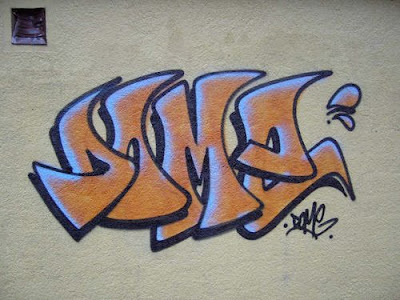>


Diego Beyró,
Orgasm series 2008 (oil on bed sheets)
Click the images to enlage
What about porn? It’s an established culture, deeply rooted in today’s modern consumer society. Porn is everywhere, and since the arrival of the Internet it is everyfuckingwhere – and people are fucking everywhere too! There’s no escaping porn. And people wouldn’t really want to escape porn, because then it wouldn’t exist, right?
I’d say most of us get sexually aroused by watching (some kind of) pornography, there’s no shame in that. It’s a combination of that suggestive attraction and our simple biological needs, I guess. Still there are people trying to ban porn and inflict censorship. I can understand that to some extent, but no porn ban will ever last. Porn is in the mindset of just about everything and it’s all over the mainstream media (MTV, Sex And The City, commercials, fashion…). Big cable operators offer adult channels and giant hotel chains offer porn on pay-per-view (as well as the mandatory Bible!).
However, to me porn is more honest than hypocritical shit like Slitz, Café and Moore (Swedish equivalents to Esquire, GQ etc); auteur maestro Micke Eklöf’s olden goldies are definitely the most honest porn films in existance… Jesus. Christ. Spermafesten.
Some might argue that that kind of men’s magazines are sensual, leaving a lot to the imagination… Hoho. Fuck that shit. Please.
This is a consumer society (stuff you can put a price tag on is real, the rest is uninteresting) and pornography is big fucking business (and thus very real). The attitude in Slitz is just plain braindead and awfully sickening.


Here’s what I’m worried about, though. It seems like today’s extreme sides of porn are becoming norm. Degeneration is at hand when humiliation, throat gagging and ”forced sex” (a term I stumbled upon just recently) is what’s expected in commercial porn. This is what bothers me. Where’s the style and intelligence? All I see is commercialized crap. People making money off the humiliation of other people. To each his own, you might say, but of course it affects society in the long run. If rape sex and stuff like that isn’t forbidden fruit anymore – if it has become your everyday treat that you’re bored with – then what’s next? Commercial child porn? Yeah, I know it sounds sick, but society is grotesque and respect is nothing but a seven letter word. It lost its meaning a long time ago. This will show as porn is driven to new extremes…
I have nothing against porn per se, but when degenerating extremes become commercialized norm… Well, I guess it’s a sign of the times.
Zeitgeist.

René Magritte, The Lovers 1928 (oil on canvas)
To finish this off I’d like to quote a brilliant essay written by Lou Reed, an essay that might skyrocket this blog’s visitors count by millions. ;) Lou shows what commercial porn is all about: exploiting humiliation. I just love his take on that porn spam shit that contaminates our mailboxes every hour (thank God for Gmail, the best spam filter ever. Who reads these mails anyway?).
”Welcome Lou” by Lou Reed
Hey Lou! These chicks will do anything for a Buck. Horny bored Housewifes are waiting for you. Watch these Bitches be ANALLY DESTROYED. Big Black cocks! How do they do it! Insane Penetrations. A Fucking Baseball Bat. No B.S. These horny women will do Anything. Why Be alone. Japanese Hardcore Anime and Kentai Art. Nasty! Over 25000 xxx by today’s best Asian Artists. These women will moan for you. The Fleshpussy. Tighter and better than the real thing and they won’t TALK BACK! Order now Mr. J. Watson of Akron writes, ”I increased the lenght of my penis by 3 in. in one week. Girth by 2 in. My wife is delighted and so am I with your invaluable product. Bigfuckin African Bros put it to the white bitchin Ho’s. What these sluts won’t do. Facial Cum Shots and our Famous Cum Shake. Yes that’s Right – I want it – I have a HARD time saying NO! Check out my home tape collection from me and my HORNY girlfriends right now! I like it in the bumbum. LOU!
See the girl next door being POUNDED! Ron wanted to shoot his wad all over MY BIG BOOBS! I finger myself at the same time. Watch The Glory Hole. These Bitches don’t care who they suck. Watch this Bitch vomit all over herself! Hear her gag and beg for MERCY! Facial Fantasies caught On Film! Sex Without Strings! Defanged and Declawed Gerbils For you Anal Ecstasy. Captain Croaker’s Anal Adventures on the Open Seas! Me and my crew go out on the open seas on the SS Stabem and find some Backdoor Virgins for your video/dvd delight. A millionaire a yacht and some sluts. INSANE PENETRATIONS! This guy said he loved my ass so much he would LICK IT! Hunting down Moms Across America. Watch these mature bitches take the Big Pony! This slut sucks a fuckin horse off till HE BLOWS IN HER MOUTH. what won’t these horny wives do for money. Why Be Alone. There out here waiting for YOU. College Chicks or their mothers, Lou. See celebrities caught on tape with their pants down. See your favorite stars. Morgue and mug shots. What did they REALLY DO?! Piss Place – watch them make a SPLASH! You’ll never miss a single drop. Live Web-Cam. On command – these sluts will DO ANYTHING YOU WANT! TABOO INSERTIONS! KINKY LADIES TAKING IT DEEP. See the Space Shuttle Booty! Thelma Tounge – Tight Asses Pounded Hard. Wet Teens. Homeless Black Women! Instant Access. Extreme anal Sex! More Extreme! Crazy! Wild! Ruining Rectums since 1998!
Her first Lesson. Real Home Blowing! Young Sluts on Wheels. Watch what she does to that Bentley! Dirty Anal! Nasty Anal! My Body wants your body Lou! 1000’s of porn clips free free free!
She put it in her mouth for the very first time, These BABES are waiting for you! Panty staining Teens! Cute young Babes with FARM ANIMALS! Smile your on Fisty Camera. My name is Young but I’m 18 and Horny! Women doing men Women doing Women! What’s Left. It’s Insane. Garbage mouthed pigs squirting cum shots and cooking pancakes at the SAME FUCKING TIME. Goddamnit get Loose. How does an ungly pig like me get the beautiful Bitches! I don’t know MONEY MONEY MONEY! Watch this Mom put AN ENTIRE REFRIGERATOR UP HER BUTT. It don’t get Better than this Jonesy. Latin Asian Greek chicks waiting for you!!!! Respond for Chrissake. Do you need Viagra – cheap cheap cheap. Horny dogs and their masters. Wowee! Waiting for you Waiting for you Waiting for you! Sex Crazed Whores with Big Tits! Respond! Respond! Snatch Party! They’ll Hunt You down To Suck you Off!
Screwing Machine! Come See Huge Dicks pounding their tight Little Pussies as these Sluts Scream for more! Woman with PHD’s Taking it up the Dung Basket. Hear them BEG IN 5 DIFFERENT LANGUAGES. My God! Respond Please! Respond Please! These woman are Waiting For you. Fornicating Giraffes. Erect Baboons. What are you Waiting for!!!!!!!!!!!!!!!!!!!!
Quoted from the book XXX 30 Porn-Star Portraits by Timothy Greenfield-Sanders.


















